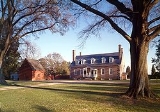
Gunston Hall
Encyclopedia
Gunston Hall is an 18th-century Georgian
mansion
near the Potomac River
in Mason Neck
, Virginia
, United States of America. The house was the home of the United States Founding Father
George Mason
. It was located at the center of a 5500 acre (22 km²) plantation
. The construction period of Gunston Hall was between 1755 and 1759.
The design was mostly that of William Buckland
, a carpenter/joiner and indentured servant
from England. Buckland later went on to design several notable buildings in Virginia and Maryland. Both he and William Bernard Sears, another indentured servant, are believed to have created the ornate woodwork and interior carving. Gunston's interior design combines elements of rococo
, chinoiserie
, and Gothic
styles, an unusual contrast to the tendency for simple decoration in Virginia at this time. Although chinoiserie was popular in Britain
, Gunston Hall is the only house known to have had this decoration in colonial America. In 1792, Thomas Jefferson
attended George Mason
at his death bed at Gunston Hall. After Mason's death later that year, the house continued to be used as a residence for many years. In 1868, it was purchased by noted abolitionist and civil war Colonel Edward Daniels
. It is now a museum open to the public.
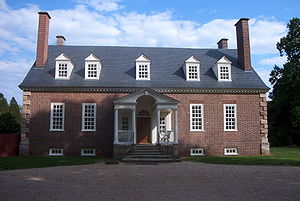 William Buckland
William Buckland
signed an indenture with Thomson Mason, George Mason's brother, on 4 August 1755, four months after he finished as an apprentice from April 1748 to April 1755. In exchange for free passage to Virginia, room and board, and a yearly salary of twenty pounds sterling, Buckland agreed to act as a carpenter and joiner for the Masons for four years.
In November, when Buckland arrived, the exterior walls of Gunston Hall were probably complete. Buckland probably did design the portico
overlooking the garden, in addition to much of the interior. The various carvings in the mansion were probably the combined work of William Buckland and William Bernard Sears. Buckland most likely provided designs for the carvings, but Sears most likely carved the wood. Buckland and Sears probably worked on much of the original furniture together. At the time, it was not uncommon for English architects to design furniture as well as buildings.
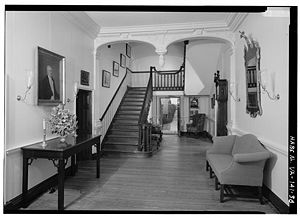 The front of the house faces northwest. The first floor of the house is divided in two by a central passage, leading from a door in the northwest to a door in the southeast, with a staircase running up on the northeast side. On the northeast side of the central passage is the primary chamber (or bedroom) in the front, and the little parlor in the back. Between the primary chamber and the little parlor is a smaller passage, leading to a service staircase and a small, side stairway. The Gunston Hall Plantation official website says that on the southwest side of the house is a parlor in the front and a dining room in the back. However, the Historic American Buildings Survey says that on the southwest side of the house the dining room is in the front and a palladian room is in the back.
The front of the house faces northwest. The first floor of the house is divided in two by a central passage, leading from a door in the northwest to a door in the southeast, with a staircase running up on the northeast side. On the northeast side of the central passage is the primary chamber (or bedroom) in the front, and the little parlor in the back. Between the primary chamber and the little parlor is a smaller passage, leading to a service staircase and a small, side stairway. The Gunston Hall Plantation official website says that on the southwest side of the house is a parlor in the front and a dining room in the back. However, the Historic American Buildings Survey says that on the southwest side of the house the dining room is in the front and a palladian room is in the back.
The central passage is lined by six symmetrical Doric
-style pilasters. A double arch, with a carved pine cone, divides the front of the passage from the back. In the front, there are four doors placed opposite one another, although one is a fake door for symmetry. The front of the hall is covered in wallpaper, while the back has raised painted paneling.
The primary chamber was a private room and was less ornate than the public rooms. Toward the end of Mason's life, it was painted in emerald green, which was considered a desirable color. The windows had pocket shutters, and are believed to be the only windows in the house to have curtains during Mason's lifetime.
The little parlor was private and decorated plainly. The walls were painted a neutral grey. Above the fireplace was a split pediment overmantel (a rectangle, and a partial triangle above that). During Mason's lifetime, the rectangle contained either a painting or a mirror. On either side of the fireplace are deep-shelved beaufats (niches) to store and display the tableware, with doors to secure valuable possessions.
The western room (called the parlor or the dining room) was a public, ornately decorated room. The walls are painted a yellow ocher, and the woodwork is Chinese-style. The wall of the fireplace has a mantel decorated with fretwork
, pagoda-like scalloped moldings, as well as canopies topped by pine cone finials. Above the doors are similar canopies, which might have displayed Chinese porcelain vases or ceramic figures. The two long windows are topped by scalloped pediments, decorated with fretwork. During Mason's lifetime, three of the walls were probably wallpapered. During the 18th century, chinoese (Chinese-style) design was popular in Great Britain, however the Gunston Hall museum does not know of any other rooms in colonial America with this type of coordinated chinoiserie
woodwork.
The southern room (called the dining room or the palladian room), was public, and was the most elaborately decorated in the house. The classical woodwork shows touches of the fashionable rococo design. The fireplace wall has an ornate chimney breast
. On either side of the fireplace are beaufats, these ones with shallower shelves than in the little parlour, and no doors. Classical broken pediments top the chimney breast and the beaufats. The floor was made of carefully matched blind-doweled planks, an expensive feature. Egg-and-dart carved patterns surround the black-walnut entry doors. During Mason's lifetime, painted or decorated paper covered the thin pine paneling on the walls. The two windows look out onto Mason's garden.
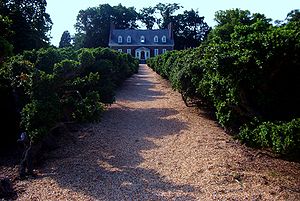 Unlike other 18th century houses of Gunston Hall's stature, the layout of the second floor is entirely dissimilar to the floor below. A narrow passage runs sideways through the upper level, leading to seven bedchambers and a storage room. At the top of the main stairway is a tri-part arch with fluted pillars, separating the passageway from a small gallery overlooking the staircase. The smaller service staircase comes up opposite the storage room.
Unlike other 18th century houses of Gunston Hall's stature, the layout of the second floor is entirely dissimilar to the floor below. A narrow passage runs sideways through the upper level, leading to seven bedchambers and a storage room. At the top of the main stairway is a tri-part arch with fluted pillars, separating the passageway from a small gallery overlooking the staircase. The smaller service staircase comes up opposite the storage room.
Of the bedchambers, only the four corner rooms have fireplaces. Their fireplaces and surrounds did have some architectural detail. The corner rooms had two or three windows each, while the inner chambers only had one window each. The walls of the corner bedchambers were painted with more expensive shades, such as Prussian blue or verdigris. The attic was accessible through one of the inner bedrooms.
The storage closet, or lumber room, had no exterior window, but instead received light from a window to the stairwell, as there was an exterior window above the staircase landing.

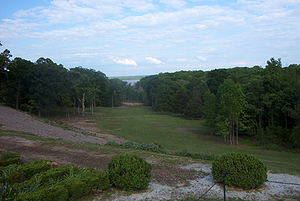 The garden was located behind the house, or on the southern side. The garden was grown above a man-made level platform where there used to be a hill, and was exactly one acre (about 4000 sq m) in area. A gravel path runs from the back of the house to the southern edge, and was twelve feet (3.7 m) wide during Mason's time period, the same width as the central passage in the house and the portico. Today, the path is narrower, crowded by boxwoods that are now about 250 years old. The path ends in an overlook extending out from the steep edge of the garden. From here, the Potomac river can be seen. The Gunston Hall museum website says that the view was more impressive during Mason's time, when the trees were cleared. The garden was most likely broken into four rectangles, with additional gravel paths running through and around it. To give the illusion from the house of all rectangles being the same size, the rectangles closer to the house were probably shorter than the rectangles farther away.
The garden was located behind the house, or on the southern side. The garden was grown above a man-made level platform where there used to be a hill, and was exactly one acre (about 4000 sq m) in area. A gravel path runs from the back of the house to the southern edge, and was twelve feet (3.7 m) wide during Mason's time period, the same width as the central passage in the house and the portico. Today, the path is narrower, crowded by boxwoods that are now about 250 years old. The path ends in an overlook extending out from the steep edge of the garden. From here, the Potomac river can be seen. The Gunston Hall museum website says that the view was more impressive during Mason's time, when the trees were cleared. The garden was most likely broken into four rectangles, with additional gravel paths running through and around it. To give the illusion from the house of all rectangles being the same size, the rectangles closer to the house were probably shorter than the rectangles farther away.
The outbuildings at Gunston Hall are reconstructed. They include a kitchen, dairy, smokehouse, and laundry. They are believed to represent typical support buildings of an 18th century plantation household. George Mason owned about 90 slaves, but the places they lived have not been located.
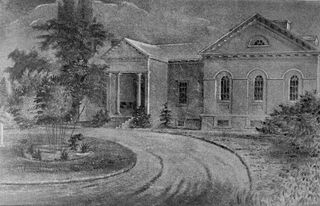 George Mason's
George Mason's
other plantations included Hollin Hall
, Woodbridge
, Lexington, and Mason's Island. His son, John Mason
, lived in Clermont
for part of his life.
George Mason gave Hollin Hall
to his third son, Thomson Mason, through deeds of gift in 1781 and 1786. The land, as given, totaled 676 acres (2.7 km²). Hollin Hall is about three miles (4.8 km) southwest of Alexandria. Late in the 18th century, it was near George Washington
's Mount Vernon
. Thomson Mason was the first member of the Mason family to live here. Before, the land was rented out to tenants. Woodbridge Plantation
used to be on the Occoquan River across from Colchester. There was a ferry there. George Mason willed the land to Thomas Mason, his youngest son, in 1792.
Lexington Plantation
was originally part of the Gunston Hall Plantation land. Lexington was given to George Mason's first son, George Mason V
. The mansion of Lexington Plantation was probably not built until after George Mason V returned from a trip to Europe in 1783.
George Mason III
bought Barbadoes Island
from Francis Hammersly in 1717, and the island came to be known as Mason's Island. George Mason
gave the island to his fourth son John Mason in 1792. Since John Mason always referred to the island as Analostan Island it came to be known by that name. During the 1790s, John ordered a summer home built there. After financial troubles, the bank foreclosed the island and John's Georgetown property in 1833. John Mason then moved to Clermont
, a 320 acre (1.3 km²) property he had recently acquired, where he spent the rest of his life.
launched in 1943,
and the USS Gunston Hall (LSD-44)
launched in 1987. Gunston Hall is also the namesake for Gunston Elementary School, in Lorton, Virginia
, Gunston Middle School in Arlington, Virginia, as well as the former athletic mascot for George Mason University
, Gunston.
Georgian architecture
Georgian architecture is the name given in most English-speaking countries to the set of architectural styles current between 1720 and 1840. It is eponymous for the first four British monarchs of the House of Hanover—George I of Great Britain, George II of Great Britain, George III of the United...
mansion
Mansion
A mansion is a very large dwelling house. U.S. real estate brokers define a mansion as a dwelling of over . A traditional European mansion was defined as a house which contained a ballroom and tens of bedrooms...
near the Potomac River
Potomac River
The Potomac River flows into the Chesapeake Bay, located along the mid-Atlantic coast of the United States. The river is approximately long, with a drainage area of about 14,700 square miles...
in Mason Neck
Mason Neck, Virginia
Mason Neck is a peninsula jutting into the Potomac River to the south of Washington, DC. It is surrounded also by Belmont Bay to the west, Gunston Cove to the east, and Pohick Bay to the northeast...
, Virginia
Virginia
The Commonwealth of Virginia , is a U.S. state on the Atlantic Coast of the Southern United States. Virginia is nicknamed the "Old Dominion" and sometimes the "Mother of Presidents" after the eight U.S. presidents born there...
, United States of America. The house was the home of the United States Founding Father
Founding Fathers of the United States
The Founding Fathers of the United States of America were political leaders and statesmen who participated in the American Revolution by signing the United States Declaration of Independence, taking part in the American Revolutionary War, establishing the United States Constitution, or by some...
George Mason
George Mason
George Mason IV was an American Patriot, statesman and a delegate from Virginia to the U.S. Constitutional Convention...
. It was located at the center of a 5500 acre (22 km²) plantation
Plantation
A plantation is a long artificially established forest, farm or estate, where crops are grown for sale, often in distant markets rather than for local on-site consumption...
. The construction period of Gunston Hall was between 1755 and 1759.
The design was mostly that of William Buckland
William Buckland (Architect)
William Buckland was an architect who designed in colonial Maryland and Virginia.-Biography:Born at Oxford, England, Buckland spent seven years as an apprentice to his uncle, James Buckland, "Citizen and Joiner" of London. At 21, he was brought to Virginia as an indentured servant to Thomas Mason,...
, a carpenter/joiner and indentured servant
Indentured servant
Indentured servitude refers to the historical practice of contracting to work for a fixed period of time, typically three to seven years, in exchange for transportation, food, clothing, lodging and other necessities during the term of indenture. Usually the father made the arrangements and signed...
from England. Buckland later went on to design several notable buildings in Virginia and Maryland. Both he and William Bernard Sears, another indentured servant, are believed to have created the ornate woodwork and interior carving. Gunston's interior design combines elements of rococo
Rococo
Rococo , also referred to as "Late Baroque", is an 18th-century style which developed as Baroque artists gave up their symmetry and became increasingly ornate, florid, and playful...
, chinoiserie
Chinoiserie
Chinoiserie, a French term, signifying "Chinese-esque", and pronounced ) refers to a recurring theme in European artistic styles since the seventeenth century, which reflect Chinese artistic influences...
, and Gothic
Gothic Revival architecture
The Gothic Revival is an architectural movement that began in the 1740s in England...
styles, an unusual contrast to the tendency for simple decoration in Virginia at this time. Although chinoiserie was popular in Britain
Kingdom of Great Britain
The former Kingdom of Great Britain, sometimes described as the 'United Kingdom of Great Britain', That the Two Kingdoms of Scotland and England, shall upon the 1st May next ensuing the date hereof, and forever after, be United into One Kingdom by the Name of GREAT BRITAIN. was a sovereign...
, Gunston Hall is the only house known to have had this decoration in colonial America. In 1792, Thomas Jefferson
Thomas Jefferson
Thomas Jefferson was the principal author of the United States Declaration of Independence and the Statute of Virginia for Religious Freedom , the third President of the United States and founder of the University of Virginia...
attended George Mason
George Mason
George Mason IV was an American Patriot, statesman and a delegate from Virginia to the U.S. Constitutional Convention...
at his death bed at Gunston Hall. After Mason's death later that year, the house continued to be used as a residence for many years. In 1868, it was purchased by noted abolitionist and civil war Colonel Edward Daniels
Edward Daniels
Edward Daniels was born in Boston, Massachusetts, but moved west to Wisconsin at the age of 21 to pursue a career as a geologist and academic...
. It is now a museum open to the public.
Construction

William Buckland (Architect)
William Buckland was an architect who designed in colonial Maryland and Virginia.-Biography:Born at Oxford, England, Buckland spent seven years as an apprentice to his uncle, James Buckland, "Citizen and Joiner" of London. At 21, he was brought to Virginia as an indentured servant to Thomas Mason,...
signed an indenture with Thomson Mason, George Mason's brother, on 4 August 1755, four months after he finished as an apprentice from April 1748 to April 1755. In exchange for free passage to Virginia, room and board, and a yearly salary of twenty pounds sterling, Buckland agreed to act as a carpenter and joiner for the Masons for four years.
In November, when Buckland arrived, the exterior walls of Gunston Hall were probably complete. Buckland probably did design the portico
Portico
A portico is a porch leading to the entrance of a building, or extended as a colonnade, with a roof structure over a walkway, supported by columns or enclosed by walls...
overlooking the garden, in addition to much of the interior. The various carvings in the mansion were probably the combined work of William Buckland and William Bernard Sears. Buckland most likely provided designs for the carvings, but Sears most likely carved the wood. Buckland and Sears probably worked on much of the original furniture together. At the time, it was not uncommon for English architects to design furniture as well as buildings.
First floor

The central passage is lined by six symmetrical Doric
Doric order
The Doric order was one of the three orders or organizational systems of ancient Greek or classical architecture; the other two canonical orders were the Ionic and the Corinthian.-History:...
-style pilasters. A double arch, with a carved pine cone, divides the front of the passage from the back. In the front, there are four doors placed opposite one another, although one is a fake door for symmetry. The front of the hall is covered in wallpaper, while the back has raised painted paneling.
The primary chamber was a private room and was less ornate than the public rooms. Toward the end of Mason's life, it was painted in emerald green, which was considered a desirable color. The windows had pocket shutters, and are believed to be the only windows in the house to have curtains during Mason's lifetime.
The little parlor was private and decorated plainly. The walls were painted a neutral grey. Above the fireplace was a split pediment overmantel (a rectangle, and a partial triangle above that). During Mason's lifetime, the rectangle contained either a painting or a mirror. On either side of the fireplace are deep-shelved beaufats (niches) to store and display the tableware, with doors to secure valuable possessions.
The western room (called the parlor or the dining room) was a public, ornately decorated room. The walls are painted a yellow ocher, and the woodwork is Chinese-style. The wall of the fireplace has a mantel decorated with fretwork
Fretwork
Fretwork is an interlaced decorative design that is either carved in low relief on a solid background, or cut out with a fretsaw, coping saw, jigsaw or scroll saw. Most fretwork patterns are geometric in design. The materials most commonly used are wood and metal. Fretwork is used to adorn...
, pagoda-like scalloped moldings, as well as canopies topped by pine cone finials. Above the doors are similar canopies, which might have displayed Chinese porcelain vases or ceramic figures. The two long windows are topped by scalloped pediments, decorated with fretwork. During Mason's lifetime, three of the walls were probably wallpapered. During the 18th century, chinoese (Chinese-style) design was popular in Great Britain, however the Gunston Hall museum does not know of any other rooms in colonial America with this type of coordinated chinoiserie
Chinoiserie
Chinoiserie, a French term, signifying "Chinese-esque", and pronounced ) refers to a recurring theme in European artistic styles since the seventeenth century, which reflect Chinese artistic influences...
woodwork.
The southern room (called the dining room or the palladian room), was public, and was the most elaborately decorated in the house. The classical woodwork shows touches of the fashionable rococo design. The fireplace wall has an ornate chimney breast
Chimney breast
A chimney breast is a portion of a wall which projects forward over a fireplace. Chimney jambs similarly project from the wall, but they do so on either side of the fireplace and serve to support the chimney breast. The interior of a chimney breast is commonly filled with brickwork or concrete....
. On either side of the fireplace are beaufats, these ones with shallower shelves than in the little parlour, and no doors. Classical broken pediments top the chimney breast and the beaufats. The floor was made of carefully matched blind-doweled planks, an expensive feature. Egg-and-dart carved patterns surround the black-walnut entry doors. During Mason's lifetime, painted or decorated paper covered the thin pine paneling on the walls. The two windows look out onto Mason's garden.
Second floor

Of the bedchambers, only the four corner rooms have fireplaces. Their fireplaces and surrounds did have some architectural detail. The corner rooms had two or three windows each, while the inner chambers only had one window each. The walls of the corner bedchambers were painted with more expensive shades, such as Prussian blue or verdigris. The attic was accessible through one of the inner bedrooms.
The storage closet, or lumber room, had no exterior window, but instead received light from a window to the stairwell, as there was an exterior window above the staircase landing.
Basement
Gunston Hall has a basement, which has a main passage and four rooms like the floor above it. Three staircases lead down to the basement. The basement contains four brick arched chimney supports, and nine small windows. In 1975, a cast iron stove was excavated from the basement. The style of the stove suggests it is from the 18th or early 19th century. Around 1986, a "shallow subsurface perimeter drainage system" was built about four feet (1.2 m) away from the foundation walls, due to an excess ground moisture. This significantly reduced standing water in the basement.Garden and outbuildings


The outbuildings at Gunston Hall are reconstructed. They include a kitchen, dairy, smokehouse, and laundry. They are believed to represent typical support buildings of an 18th century plantation household. George Mason owned about 90 slaves, but the places they lived have not been located.
Visitors' center and museum shop
At the visitors' center, there is an 11-minute film entitled "George Mason and the Bill of Rights". The exhibit covers Mason's political career, personal life, and 18th century plantation culture. Gunston Hall is open from 9:30 a.m. to 5 p.m. EST, except for the holidays Thanksgiving, Christmas, and New Year's Day. A 45-minute tour is offered every half hour, with the last tour starting at 4:30 p.m. The museum shop sells souvenirs such as books, gift items, soap, food, and toys. The museum shop's stated purpose is to educate today's citizens about 18th century life in Virginia.Other Mason plantations

George Mason
George Mason IV was an American Patriot, statesman and a delegate from Virginia to the U.S. Constitutional Convention...
other plantations included Hollin Hall
Hollin Hall
Hollin Hall is an 18th century plantation home on Little Hunting Creek three miles southwest of Alexandria in Fairfax County, Virginia. George Mason, a United States founding father, gave Hollin Hall to his third son, Thomson Mason, through deeds of gift in 1781 and 1786. The land, as given,...
, Woodbridge
Woodbridge Plantation
Woodbridge was a plantation formerly located on the Occoquan River in Prince William County, Virginia, across from Colchester. There was a ferry there. George Mason, a United States founding father, willed the land to Thomas Mason, his youngest son, in 1792. The unincorporated city of Woodbridge...
, Lexington, and Mason's Island. His son, John Mason
John Mason (1766–1849)
John Mason was an early American merchant, banker, planter. As a son of George Mason, a Founding Father of the United States, Mason was a scion of the prominent Mason political family.-Early life and education:...
, lived in Clermont
Clermont (Alexandria, Virginia)
Clermont was an 18th-century plantation in Fairfax County Clermont was an 18th-century plantation in Fairfax County Clermont was an 18th-century plantation in Fairfax County (now Alexandria, Virginia, United States. Clermont is best known as the home of John Mason (4 April 1766–19 March...
for part of his life.
George Mason gave Hollin Hall
Hollin Hall
Hollin Hall is an 18th century plantation home on Little Hunting Creek three miles southwest of Alexandria in Fairfax County, Virginia. George Mason, a United States founding father, gave Hollin Hall to his third son, Thomson Mason, through deeds of gift in 1781 and 1786. The land, as given,...
to his third son, Thomson Mason, through deeds of gift in 1781 and 1786. The land, as given, totaled 676 acres (2.7 km²). Hollin Hall is about three miles (4.8 km) southwest of Alexandria. Late in the 18th century, it was near George Washington
George Washington
George Washington was the dominant military and political leader of the new United States of America from 1775 to 1799. He led the American victory over Great Britain in the American Revolutionary War as commander-in-chief of the Continental Army from 1775 to 1783, and presided over the writing of...
's Mount Vernon
Mount Vernon
The name Mount Vernon is a dedication to the English Vice-Admiral Edward Vernon. It was first applied to Mount Vernon, the Virginia estate of George Washington, the first President of the United States...
. Thomson Mason was the first member of the Mason family to live here. Before, the land was rented out to tenants. Woodbridge Plantation
Woodbridge Plantation
Woodbridge was a plantation formerly located on the Occoquan River in Prince William County, Virginia, across from Colchester. There was a ferry there. George Mason, a United States founding father, willed the land to Thomas Mason, his youngest son, in 1792. The unincorporated city of Woodbridge...
used to be on the Occoquan River across from Colchester. There was a ferry there. George Mason willed the land to Thomas Mason, his youngest son, in 1792.
Lexington Plantation
Lexington Plantation
Lexington was an 18th-century plantation on Mason's Neck in Fairfax County, Virginia, United States. The estate belonged to several generations of the Mason family....
was originally part of the Gunston Hall Plantation land. Lexington was given to George Mason's first son, George Mason V
George Mason V
George Mason V of Lexington was a planter, businessman, and militia leader. Mason was the eldest son of United States patriot, statesman, and delegate from Virginia to the U.S. Constitutional Convention, George Mason IV....
. The mansion of Lexington Plantation was probably not built until after George Mason V returned from a trip to Europe in 1783.
George Mason III
George Mason III
George Mason III was an early American planter, businessman, and statesman. Mason was the father of George Mason IV, a Founding Father of the United States.-Early life:...
bought Barbadoes Island
Theodore Roosevelt Island
Theodore Roosevelt Island is a island and a national memorial located in the Potomac River in Washington, D.C. The island was given to the American people by the Theodore Roosevelt Association in memory of the 26th U.S. president, Theodore Roosevelt....
from Francis Hammersly in 1717, and the island came to be known as Mason's Island. George Mason
George Mason
George Mason IV was an American Patriot, statesman and a delegate from Virginia to the U.S. Constitutional Convention...
gave the island to his fourth son John Mason in 1792. Since John Mason always referred to the island as Analostan Island it came to be known by that name. During the 1790s, John ordered a summer home built there. After financial troubles, the bank foreclosed the island and John's Georgetown property in 1833. John Mason then moved to Clermont
Clermont (Alexandria, Virginia)
Clermont was an 18th-century plantation in Fairfax County Clermont was an 18th-century plantation in Fairfax County Clermont was an 18th-century plantation in Fairfax County (now Alexandria, Virginia, United States. Clermont is best known as the home of John Mason (4 April 1766–19 March...
, a 320 acre (1.3 km²) property he had recently acquired, where he spent the rest of his life.
As a namesake
Gunston Hall was the namesake of the USS Gunston Hall (LSD-5)USS Gunston Hall (LSD-5)
USS Gunston Hall was an in the United States Navy, named in honor of Gunston Hall, the estate of George Mason , one of the Founding Fathers of the United States....
launched in 1943,
and the USS Gunston Hall (LSD-44)
USS Gunston Hall (LSD-44)
USS Gunston Hall is a of the United States Navy. She was the second Navy ship to be named for Gunston Hall, the Mason Neck, Virginia estate of George Mason, one of Virginia's outstanding Revolutionary figures, and "Father of the Bill of Rights"....
launched in 1987. Gunston Hall is also the namesake for Gunston Elementary School, in Lorton, Virginia
Lorton, Virginia
Lorton is a census-designated place in Fairfax County, Virginia, United States. The population is 27,709 as of the 2008 census estimate.-History:...
, Gunston Middle School in Arlington, Virginia, as well as the former athletic mascot for George Mason University
George Mason University
George Mason University is a public university based in unincorporated Fairfax County, Virginia, United States, south of and adjacent to the city of Fairfax. Additional campuses are located nearby in Arlington County, Prince William County, and Loudoun County...
, Gunston.
Further reading
- Copied from:

